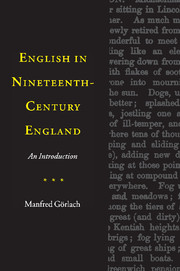Book contents
- Frontmatter
- Contents
- List of abbreviations
- Preface
- Acknowledgements
- List of figures
- List of texts
- 1 Introduction
- 2 Regional and social varieties
- 3 Spelling and pronunciation
- 4 Inflection
- 5 Syntax
- 6 Lexis
- 7 Text types and style
- 8 Provisional conclusions
- 9 Texts
- 10 Information on texts and authors
- References
- Index of names
- Index of topics and titles
- Index of selected words and pronunciations
10 - Information on texts and authors
Published online by Cambridge University Press: 17 May 2010
- Frontmatter
- Contents
- List of abbreviations
- Preface
- Acknowledgements
- List of figures
- List of texts
- 1 Introduction
- 2 Regional and social varieties
- 3 Spelling and pronunciation
- 4 Inflection
- 5 Syntax
- 6 Lexis
- 7 Text types and style
- 8 Provisional conclusions
- 9 Texts
- 10 Information on texts and authors
- References
- Index of names
- Index of topics and titles
- Index of selected words and pronunciations
Summary
The following notes include information on the selected 19th-century texts, the sources of the excerpts, information on authors (taken from the Dictionary of National Biography and introductions to the individual works) and a few remarks on the relevance of the texts. References to scholarly discussions of the works are provided where available; ‘Görlach ABib’ with accompanying number refers to my annotated bibliography of 19th-century grammars (= Görlach 1998a).
On language, grammar and style
TI: From: Revd. Alexander Crombie, LL.D. The Etymology and Syntax of the English Language, Explained and Illustrated. London: for J. Johnson, 1802:235–8. The passage is reprinted without changes in later editions, as in 91865:256–7. (Görlach ABib 390)
A conservative account of the diversity and poor expressiveness of the vernacular as spoken by the illiterate ‘vulgar’, contrasted with written norms as defined by the usage of reputable authors.
T2: From: James Andrew. Institutes of Grammar. London: Black, Parbury & Allen, 1817:91–8. (Görlach ABib 43)
Extensive advice geared to functionally defined text types and literary genres endebted to the classical idea of decorum (without using the categories developed by traditional rhetoric).
T3: From: William Cobbett. A Grammar of the English Language, in a Series of Letters. Intended for the use of schools and of young persons in general; but more especially for the use of soldiers, sailors, apprentices and plough-boys. To which are added, six lessons to prevent statesmen from using false grammar, and from writing in an awkward manner.
- Type
- Chapter
- Information
- English in Nineteenth-Century EnglandAn Introduction, pp. 286 - 302Publisher: Cambridge University PressPrint publication year: 1999



